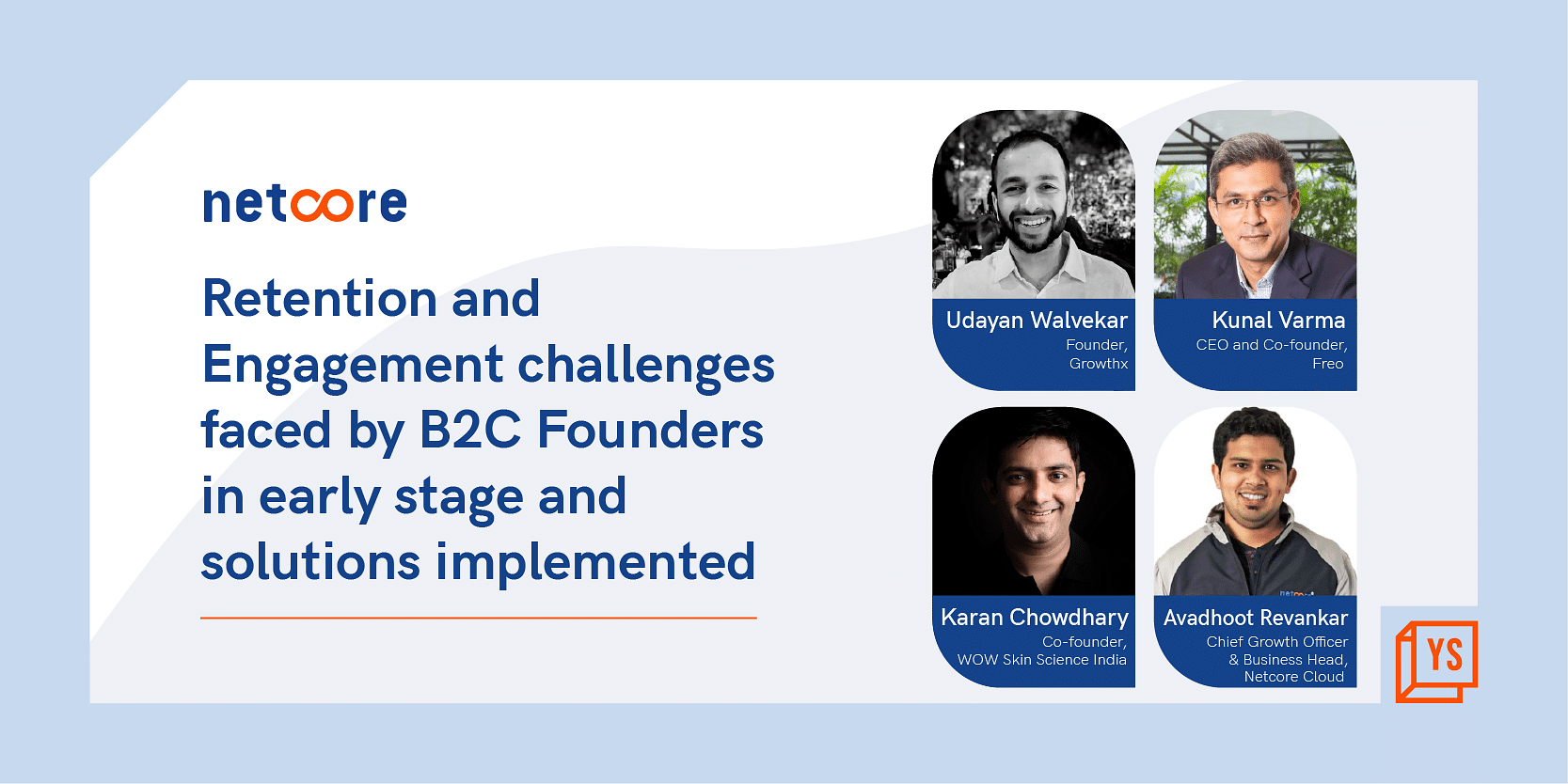For most D2C or app-based early-stage startups, customer acquisition, retention, and engagement can be tricky. However, it is an integral part of any organisation’s growth strategy. With a rise in competition in the market and multiple options for the customer to choose from, early-stage startups must make it a priority to retain customers as they grow.
Effective strategies will engage the right customer base, build a long-lasting relationship with them, drive sales, strengthen your brand value, create loyalty, and ultimately will drive retention.
The only question is, how do you go about building that strategy? Are you prepared for the challenges you will face?
Netcore Cloud – a company that offers a no code customer engagement platform – conducted a webinar titled ‘Up your retention and engagement game’ on March 15 to answer these questions. With a guest panel consisting of three successful startup founders, and Netcore’s Chief Growth Officer and Business Head, the webinar examined different customer-related challenges that these founders experienced in the early days of their businesses, and how they overcame them. The panel, consisting of Udayan Walvekar, Founder, Growthx; Kunal Varma, CEO and Co-founder, Freo; Karan Chowdhary, Co-founder, WOW Skin Science India; and Avadhoot Revankar, Chief Growth Officer and Business Head, Netcore Cloud discussed various aspects of customer retention and engagement faced in the early stages of business.
You can watch the entire webinar,
Building customer trust takes time
Building a long-term and enduring relationship with your customer base is a vital factor to any business longevity. At the heart of these relationships is trust. When companies build trust, their customers automatically begin to advocate for them, leading to increased brand visibility, more customers and revenue.
However, Kunal pointed out that while trust is incredibly effective, it’s also hard to build – particularly in a sensitive sector like finance. At Freo, India’s first credit-led neobank, Kunal notes that the process of building trust started from day one. Furthemore, he noted that transparency in communication was vital. At Freo, transparency is baked into the processes, privacy, and information sharing. Secondly, he advocated strongly for companies to own up when they made a mistake, apologise, and then rectify the mistake. Actions like these can improve customer interactions, while simultaneously building trust with the customer.
Going beyond customer acquisition
Avadhoot cited customer retention as one of the most important roadblocks that early-stage startups face when it comes to building a customer base. “Early-stage startups tend to place a lot of emphasis on acquiring new customers, without taking any further steps to build the relationship,” he said.
He spoke about the need to activate users, offer them the right onboarding experience, instead of letting the customer figure these processes out by themselves. He also spoke of personalising the customer experience and the need to help customers find the right products on the website / app. Finally, the third important challenge for startups to consider was creating a channel of communication with their customers beyond the first purchase. This, Avadhoot said, would require more than discounts and promotions to buy the next product. Instead, early-stage startups should build a more personalised conversation with their customers.
Frameworks to truly know your customers
Udayan spoke about different frameworks he uses to get to know his customers. One of the best frameworks to truly understand who the customer is the ICP (Ideal Customer Profile). The second framework, he discussed, was the Customer Journey Map – a diagram that depicts the phases customers undergo when interacting with a business. “A customer journey map really helps you to understand what your customers are doing, while they’re evaluating your product,” he said. The final framework was JTBC (Jobs To Be Done). This approach develops products based on the understanding that the customer is looking to “hire” a product in order to fulfil their goal or complete their job.
In a fascinating analogy, Udayan likened customer churn to friendship. He said, before a friendship ends there will be all kinds of signs and behavioural changes that the friend exhibits. Customer churn, in this analogy, was the last attempt made to repair and resurrect the friendship. He recommended that companies should start fixing the problems in customer experience from the customer activation stage, and consistently make efforts to keep the spark alive in the relationship (or in this analogy, friendship) alive. Udayan also spoke about two key factors in customer churn – one is the conversations companies have with customers to determine if the churn reasons are solvable or not. The second is redoing campaigns, offering discounts and utilising tools like mixpanel to figure out where users are dropping off.
Leveraging hyper personalisation to solve consumer problems
“At some level, hyper personalisation – like all powerful forces – can become a double edged sword, if not understood and implemented well,” said Kunal. However, if hyperpersonlisation is leveraged correctly, companies will inevitably start focusing on the most relevant customer problems to solve, such as turnaround time, latency issues, actual customer experience interaction design, call to action, and how much time and energy the customer is spending with you in your product ecosystem.
He cited the example of Freo’s credit line, which is built on an in-house, intuitive chat-based system, built from scratch. Customers can chat in seven Indian languages or English. Although the system is not a full fledged AI system, it acts as a smart system in terms of understanding how to respond and guiding the customer in the right direction. However, Kunal also stressed that companies shouldn’t be too eager to use terms like hyper personalisation, unless they’re absolutely certain they can deliver these in-depth, customised experiences to their users.
Customers for a lifetime
According to Avadhoot, “the key to lifetime retention is the experience brands create right from the first interaction, and then onwards”. This is the force that drives many Netcore tools and solutions. Avadhoot cited the case of Khatabook, a book-keeping app for shop owners, where Netcore Cloud was able to create personalised, contextual experiences in the customer journey, therefore increasing retention rates.
The company was facing the challenge of a customer base that was not digitally savvy. Khatabook then approached Netcore Cloud to ensure that these merchants are activated as soon as possible. The app then used Netcore Cloud’s guided onboarding to ensure that the merchant was able to add their employee details, salary payments, staff views, and more. With just a few clicks, guided nudges, the app was able to accumulate roughly about three and a half times the amount of employee details filled in by the merchants.
Interactions over automation in the early days
Karan stated that in the early days of a startup, it is both tough and wrong to base any customer-related decisions on automation or AI. This was especially important when customers were trying to make improvements to a product based on customer feedback. Early-stage startups should focus on customer reasons for buying a product. He said, customers usually give companies one chance, so instead of using that on AI or automation, companies should opt for a more empathetic, human approach. Customers would be far more receptive to that, and would likely offer vital feedback to improve the product. When the company has confidence in the product, has taken customer feedback into consideration and tested it multiple times, they can start looking at automation.
From learning different frameworks to understand and segment viewers, learning about churn, creating customised customer experiences to the use of automation and AI, this webinar is packed with incredible and helpful insights to help early stage startups retain and engage customers.



![Read more about the article [Funding alert] Innovaccer raises $150M at a valuation of $3.2B](https://blog.digitalsevaa.com/wp-content/uploads/2021/12/innovaccer-founder-final-1639581661937-300x150.png)






